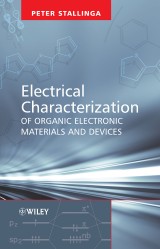Details

Electrical Characterization of Organic Electronic Materials and Devices
1. Aufl.
|
125,99 € |
|
| Verlag: | Wiley |
| Format: | |
| Veröffentl.: | 08.10.2009 |
| ISBN/EAN: | 9780470750179 |
| Sprache: | englisch |
| Anzahl Seiten: | 316 |
DRM-geschütztes eBook, Sie benötigen z.B. Adobe Digital Editions und eine Adobe ID zum Lesen.
Beschreibungen
<b>Think like an electron</b> <p>Organic electronic materials have many applications and potential in low-cost electronics such as electronic barcodes and in light emitting devices, due to their easily tailored properties. While the chemical aspects and characterization have been widely studied, characterization of the electrical properties has been neglected, and classic textbook modeling has been applied. This is most striking in the analysis of thin-film transistors (TFTs) using thick “bulk” transistor (MOS-FET) descriptions. At first glance the TFTs appear to behave as regular MOS-FETs. However, upon closer examination it is clear that TFTs are unique and merit their own model. Understanding and interpreting measurements of organic devices, which are often seen as black-box measurements, is critical to developing better devices and this, therefore, has to be done with care.</p> <p><i>Electrical Characterization of Organic Electronic Materials and Devices</i></p> <ul> <li>Gives new insights into the electronic properties and measurement techniques for low-mobility electronic devices</li> <li>Characterizes the thin-film transistor using its own model</li> <li>Links the phenomena seen in different device structures and different measurement techniques</li> <li>Presents clearly both how to perform electrical measurements of organic and low-mobility materials and how to extract important information from these measurements</li> <li>Provides a much-needed theoretical foundation for organic electronics</li> </ul>
<b>Preface.</b> <p><b>1 General concepts</b>.</p> <p>1.1 Introduction.</p> <p>1.2 Conduction mechanism.</p> <p>1.3 Chemistry and the energy diagram.</p> <p>1.4 Disordered materials and the Meyer–Neldel Rule.</p> <p>1.5 Devices.</p> <p>1.6 Optoelectronics/photovoltaics.</p> <p><b>2 Two-terminal devices: DC current</b>.</p> <p>2.1 Conductance.</p> <p>2.2 DC current of a Schottky barrier.</p> <p>2.3 DC measurements.</p> <p><b>3 Two-terminal devices: Admittance spectroscopy</b>.</p> <p>3.1 Admittance spectroscopy.</p> <p>3.2 Geometrical capacitance.</p> <p>3.3 Equivalent circuits.</p> <p>3.4 Resistor; SCLC.</p> <p>3.5 Schottky diodes.</p> <p>3.6 MIS diodes.</p> <p>3.7 MIS tunnel diode.</p> <p>3.8 Noise measurements.</p> <p><b>4 Two-terminal devices: Transient techniques</b>.</p> <p>4.1 Kinetics: Emission and capture of carriers.</p> <p>4.2 Current transient spectroscopy.</p> <p>4.3 Thermally stimulated current.</p> <p>4.4 Capacitance transient spectroscopy.</p> <p>4.5 Deep-level transient spectroscopy.</p> <p>4.6 Q-DLTS.</p> <p><b>5 Time-of-flight</b>.</p> <p>5.1 Introduction.</p> <p>5.2 Drift transient.</p> <p>5.3 Diffusive transient.</p> <p>5.4 Violating einstein’s relation.</p> <p>5.5 Multi-trap-and-release.</p> <p>5.6 Anomalous transients.</p> <p>5.7 High current (space charge) transients.</p> <p>5.8 Summary of the ToF technique.</p> <p><b>6 Thin-film transistors</b>.</p> <p>6.1 Field-effect transistors.</p> <p>6.2 MOS-FET.</p> <p>6.3 Introducing TFTs.</p> <p>6.4 Basic model.</p> <p>6.5 Justification for the two-dimensional approach.</p> <p>6.6 Ambipolar materials and devices.</p> <p>6.7 Contact effects and other simple nonidealities.</p> <p>6.8 Metallic contacts in TFTs.</p> <p>6.9 Normally-on TFTs.</p> <p>6.10 Effects of traps.</p> <p>6.11 Admittance spectroscopy for the determination of the mobility in TFTs.</p> <p>6.12 Summary of TFT measurements.</p> <p>6.13 Diffusion transistor.</p> <p><b>Appendix A A Derivation of Equations (2.21), (2.25), (6.95) and (6.101)</b>.</p> <p><b>Bibliography</b>.</p> <p>Index.</p>
<p><strong>Peter Stallinga</strong> is a professor at the Universidade do Algarve (Portugal) in the Department of Electronic Engineering and Informatica. He obtained his PhD in Physics at the University of Amsterdam (The Netherlands). From 1994 to 1995, Professor Stallinga was a postdoctoral researcher at the University of California at Berkeley (USA). He then moved to Denmark, where he worked as a postdoctoral researcher at the University of Aarhus. From 1997 to 1999, he was a postdoctoral researcher at the Universidade do Algarve. His main area of scientific research is the physics of electronic materials and other areas of interest include informatics, electronics, and biotechnology. He is an experienced lecturer and parts of the material in this book have been given as lectures at the summer school of a European network on organic electronics (SELOA and MONA-LISA).
<b>Think like an electron</b> <p>Organic electronic materials have many applications and potential in low-cost electronics such as electronic barcodes and in light emitting devices, due to their easily tailored properties. While the chemical aspects and characterization have been widely studied, characterization of the electrical properties has been neglected, and classic textbook modeling has been applied. This is most striking in the analysis of thin-film transistors (TFTs) using thick “bulk” transistor (MOS-FET) descriptions. At first glance the TFTs appear to behave as regular MOS-FETs. However, upon closer examination it is clear that TFTs are unique and merit their own model. Understanding and interpreting measurements of organic devices, which are often seen as black-box measurements, is critical to developing better devices and this, therefore, has to be done with care.</p> <p><i>Electrical Characterization of Organic Electronic Materials and Devices</i></p> <ul> <li>Gives new insights into the electronic properties and measurement techniques for low-mobility electronic devices</li> <li>Characterizes the thin-film transistor using its own model</li> <li>Links the phenomena seen in different device structures and different measurement techniques</li> <li>Presents clearly both how to perform electrical measurements of organic and low-mobility materials and how to extract important information from these measurements</li> <li>Provides a much-needed theoretical foundation for organic electronics</li> </ul>


















